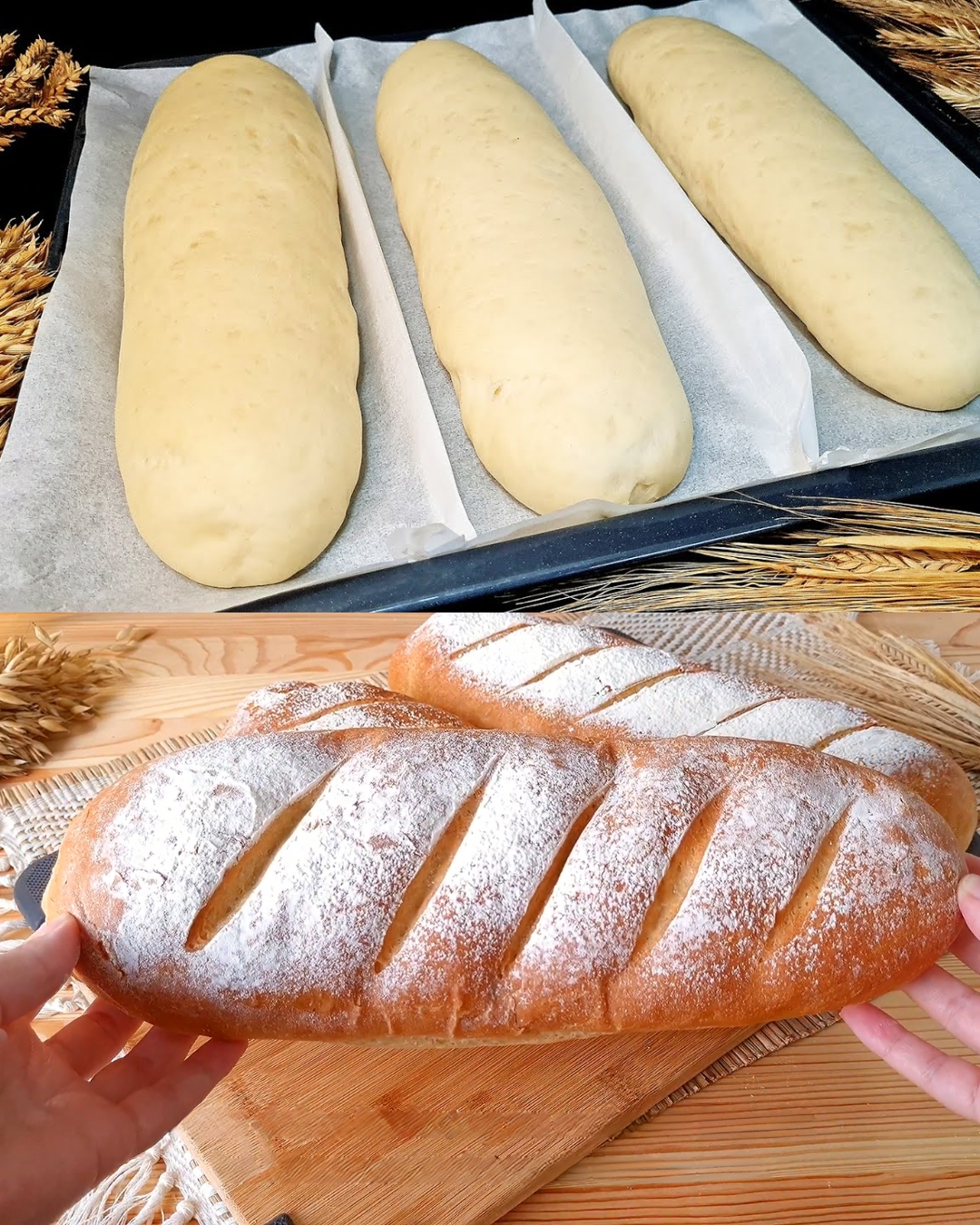Few things in life are as satisfying as the aroma of freshly baked bread filling your kitchen. The moment you slice through that golden-brown crust and reveal the warm, airy crumb inside, you know all the waiting and kneading were worth it. This Homemade Crusty Bread recipe is proof that you don’t need fancy equipment or rare ingredients to create bakery-quality bread at home. All you need is a handful of pantry staples, a little patience, and the willingness to let yeast work its magic.
What makes this bread so appealing is its versatility. You can use it as a base for sandwiches, serve it alongside soups and stews, or enjoy it simply with a smear of butter. Its firm crust gives way to a soft, tender interior, creating the kind of bite that satisfies in every way. This is a rustic loaf — no frills, no complicated techniques, just good, honest bread that tastes exactly the way homemade bread should.
Whether you’re new to bread baking or a seasoned home baker, this recipe will quickly become a staple in your kitchen. The process is straightforward, the ingredients are affordable, and the results are consistently impressive. Once you’ve made it once, you’ll start imagining all the variations you could try — from herb-infused dough to sweetened loaves perfect for breakfast. But first, let’s master the classic.
Full Recipe
Ingredients
-
550 g wheat flour
-
2 tablespoons sugar
-
1 teaspoon salt
-
10 g dry yeast
-
300 ml warm water
-
30 ml vegetable oil
-
Extra flour for dusting
Cooking Directions
-
Prepare the yeast mixture. In a mixing bowl, combine the dry yeast, sugar, and warm water. Stir lightly and allow it to rest for 5–10 minutes until frothy. This step ensures the yeast is active and ready to leaven the bread.
-
Mix the dough. Add the flour and salt to the yeast mixture. Stir until a rough dough forms, then pour in the vegetable oil. Mix until all the ingredients are well incorporated.
-
Knead the dough. Transfer the dough to a floured surface and knead for 8–10 minutes until smooth and elastic. You can also knead the dough in a stand mixer with a dough hook.
-
First rest. Divide the dough into 3 equal parts. Shape each piece into a ball or oval loaf. Place them on a lightly floured baking tray. Cover loosely with a clean kitchen towel and let rest for 15 minutes.
-
Shape and score. Lightly brush or spray the surface of each loaf with water. This will help create a crisp crust. Sprinkle with a little flour for a rustic appearance, then use a sharp knife to make small cuts on the top — these allow steam to escape and give the bread an artisanal look.
-
Bake. Preheat the oven to 180°C (356°F). Bake the loaves for 25–30 minutes, or until the crust is golden and the bread sounds hollow when tapped on the bottom.
-
Cool and enjoy. Transfer the bread to a wire rack to cool for at least 10–15 minutes before slicing. Serve warm or at room temperature with your favorite spreads or dishes.
Nutrients (per loaf, approximate)
-
Calories: 130 kcal (per serving, based on 12 servings)
-
Protein: 4 g
-
Fat: 2 g
-
Carbohydrates: 26 g
-
Fiber: 1 g
-
Sugar: 1 g
-
Sodium: 200 mg
Why You’ll Love This Recipe
This recipe is bread in its purest form — straightforward, satisfying, and endlessly versatile. There’s no complex shaping or long list of ingredients to track down. The short rest time before baking means you can have fresh bread on the table in under an hour, making it ideal for busy weeknights or last-minute dinner guests. The texture hits that perfect balance: a hearty crust with a soft, pillowy center. Plus, the flavor is mild, which means it pairs well with both sweet and savory toppings.
The Origins and Inspiration Behind the Dish
Bread is one of the oldest prepared foods in human history, with variations appearing across every culture and cuisine. This recipe takes inspiration from rustic European country loaves, where the focus is on quality ingredients and simple preparation. The method here — a basic yeast dough, shaped and baked with minimal proofing — mirrors the kind of bread rural families would have made daily for the table. The scoring on top not only adds visual charm but also has a functional purpose in helping the bread bake evenly.
Ingredient Spotlight
-
Wheat Flour: The backbone of the recipe, providing structure and chew. Use bread flour for extra gluten strength or stick to all-purpose for a softer crumb.
-
Dry Yeast: Reliable and easy to store, dry yeast helps the bread rise quickly.
-
Vegetable Oil: Adds moisture and tenderness without weighing down the crumb.
-
Sugar: Feeds the yeast and adds a subtle sweetness to balance the salt.
-
Salt: Enhances flavor and helps control yeast activity for even fermentation.
Storage and Reheating Tips
Fresh bread is always best the day it’s baked, but you can store it in a paper bag or bread box at room temperature for up to 2 days. If you need to keep it longer, wrap it tightly in plastic wrap and store in the freezer for up to 1 month. To reheat, place the bread in a preheated 150°C (300°F) oven for about 5–10 minutes to restore its crisp crust and soft interior. Avoid refrigerating bread, as it can dry out faster.
Common Variations to Try
-
Herb Bread: Add dried rosemary, thyme, or oregano to the dough for extra flavor.
-
Garlic Bread: Brush the loaves with garlic-infused butter before baking.
-
Seeded Loaf: Sprinkle sesame seeds, sunflower seeds, or flaxseeds over the top before baking.
-
Sweet Loaf: Increase the sugar slightly and add cinnamon for a mildly sweet breakfast bread.
Pairing Recommendations
This bread is a natural partner for hearty soups and stews, soaking up flavorful broths without falling apart. It’s also perfect for sandwiches — from a classic BLT to a grilled cheese. For breakfast, try it toasted with butter and jam, or topped with avocado and a sprinkle of salt. If you’re serving it at dinner, pair it with a charcuterie board, dips, or olive oil and balsamic vinegar for dipping.
Advertisement
Health Benefits
While this bread is simple, it offers some nutritional value from its wheat flour, providing carbohydrates for energy and small amounts of protein. The low fat content makes it lighter than many store-bought breads, which often contain added sugars and preservatives. Because it’s homemade, you know exactly what’s in it — no artificial additives, no excess sodium, just pure, wholesome ingredients.
Conclusion
There’s a reason why bread baking never goes out of style — it’s one of the most rewarding kitchen skills you can develop. This Homemade Crusty Bread is the perfect starting point for anyone who wants to enjoy the unbeatable taste of fresh, warm bread straight from their own oven. It’s a recipe you’ll return to again and again, whether you keep it classic or explore different flavors and toppings. With just a few ingredients and a bit of time, you can turn your kitchen into a personal bakery and enjoy the simple pleasure of homemade bread any day of the week.

